Heuristic Evaluation Report: Analysis of User Interface Design
VerifiedAdded on 2023/01/05
|6
|1328
|57
Report
AI Summary
This report presents a heuristic evaluation of an application, assessing its usability based on principles such as user control, human limitations, and linguistic clarity. The evaluation covers various aspects of the user interface, including menu navigation, visual design, and error handling. The report analyzes the application's adherence to established usability heuristics, identifying strengths and weaknesses. It examines aspects like aesthetic integrity, simplicity, predictability, and responsiveness to user actions. The evaluation also considers the application's flexibility, consistency, and user support mechanisms, providing a comprehensive analysis of the user experience. The report concludes with a bibliography of relevant sources. This document is contributed by a student to be published on Desklib, a platform providing AI-based study tools.
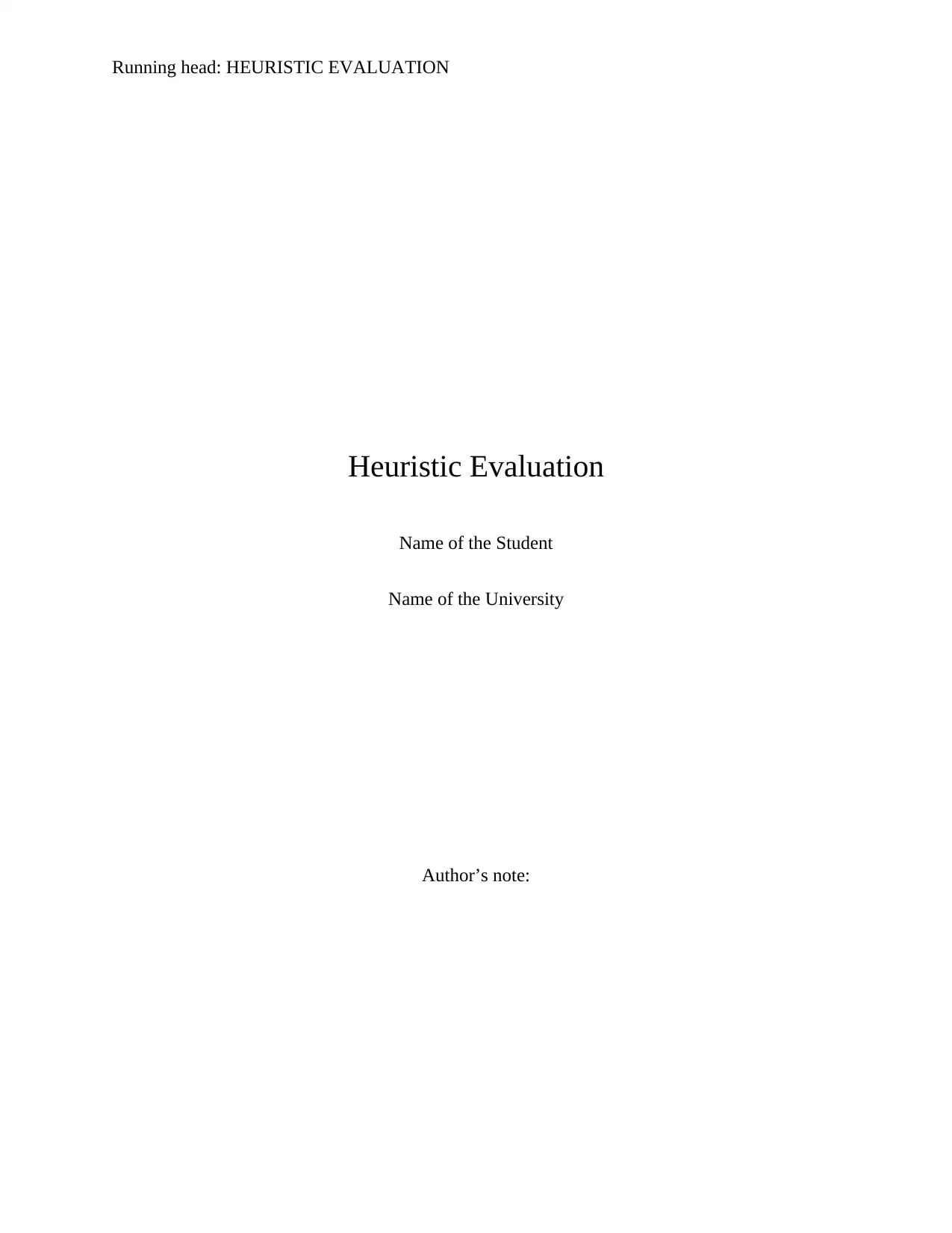
Running head: HEURISTIC EVALUATION
Heuristic Evaluation
Name of the Student
Name of the University
Author’s note:
Heuristic Evaluation
Name of the Student
Name of the University
Author’s note:
Paraphrase This Document
Need a fresh take? Get an instant paraphrase of this document with our AI Paraphraser
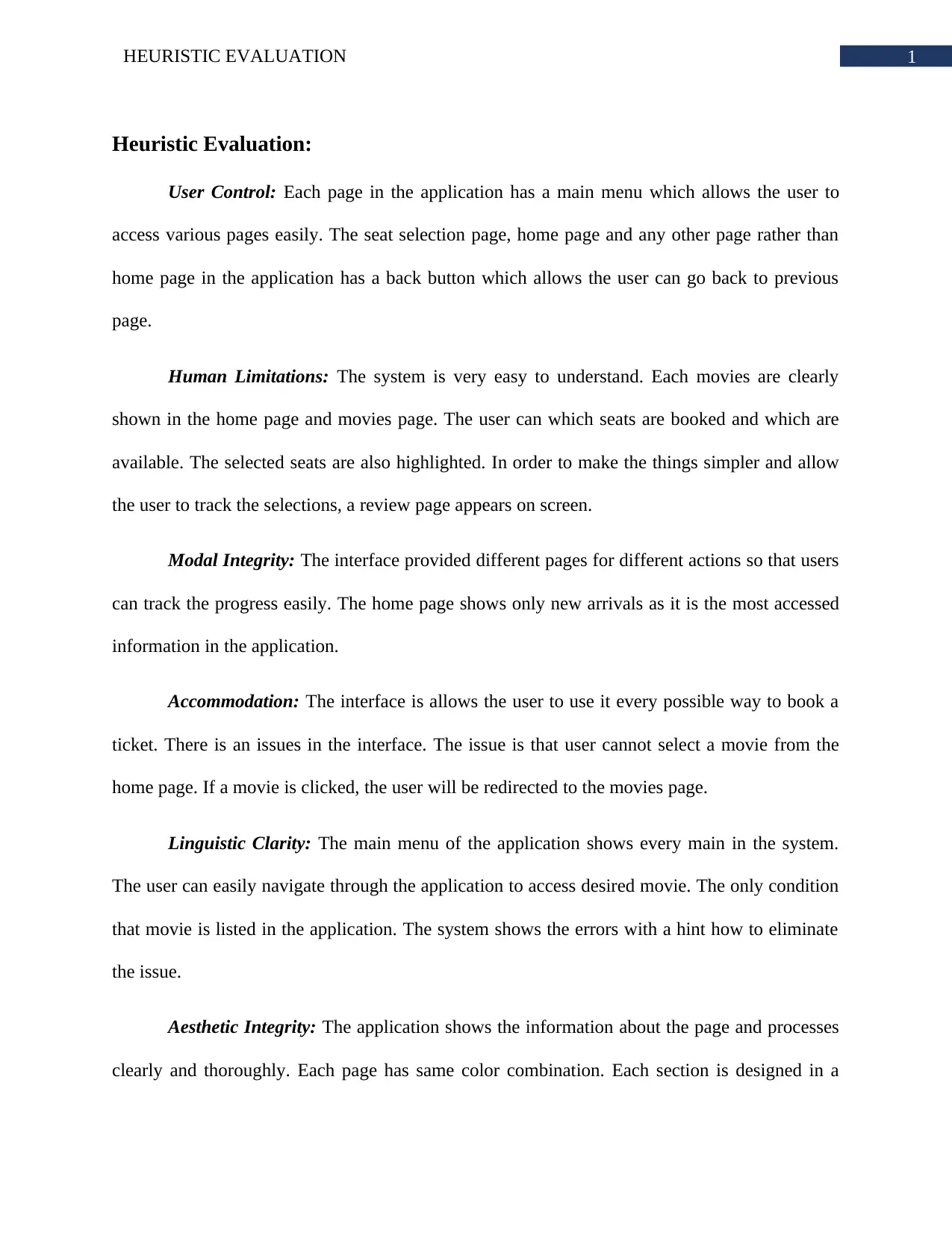
1HEURISTIC EVALUATION
Heuristic Evaluation:
User Control: Each page in the application has a main menu which allows the user to
access various pages easily. The seat selection page, home page and any other page rather than
home page in the application has a back button which allows the user can go back to previous
page.
Human Limitations: The system is very easy to understand. Each movies are clearly
shown in the home page and movies page. The user can which seats are booked and which are
available. The selected seats are also highlighted. In order to make the things simpler and allow
the user to track the selections, a review page appears on screen.
Modal Integrity: The interface provided different pages for different actions so that users
can track the progress easily. The home page shows only new arrivals as it is the most accessed
information in the application.
Accommodation: The interface is allows the user to use it every possible way to book a
ticket. There is an issues in the interface. The issue is that user cannot select a movie from the
home page. If a movie is clicked, the user will be redirected to the movies page.
Linguistic Clarity: The main menu of the application shows every main in the system.
The user can easily navigate through the application to access desired movie. The only condition
that movie is listed in the application. The system shows the errors with a hint how to eliminate
the issue.
Aesthetic Integrity: The application shows the information about the page and processes
clearly and thoroughly. Each page has same color combination. Each section is designed in a
Heuristic Evaluation:
User Control: Each page in the application has a main menu which allows the user to
access various pages easily. The seat selection page, home page and any other page rather than
home page in the application has a back button which allows the user can go back to previous
page.
Human Limitations: The system is very easy to understand. Each movies are clearly
shown in the home page and movies page. The user can which seats are booked and which are
available. The selected seats are also highlighted. In order to make the things simpler and allow
the user to track the selections, a review page appears on screen.
Modal Integrity: The interface provided different pages for different actions so that users
can track the progress easily. The home page shows only new arrivals as it is the most accessed
information in the application.
Accommodation: The interface is allows the user to use it every possible way to book a
ticket. There is an issues in the interface. The issue is that user cannot select a movie from the
home page. If a movie is clicked, the user will be redirected to the movies page.
Linguistic Clarity: The main menu of the application shows every main in the system.
The user can easily navigate through the application to access desired movie. The only condition
that movie is listed in the application. The system shows the errors with a hint how to eliminate
the issue.
Aesthetic Integrity: The application shows the information about the page and processes
clearly and thoroughly. Each page has same color combination. Each section is designed in a
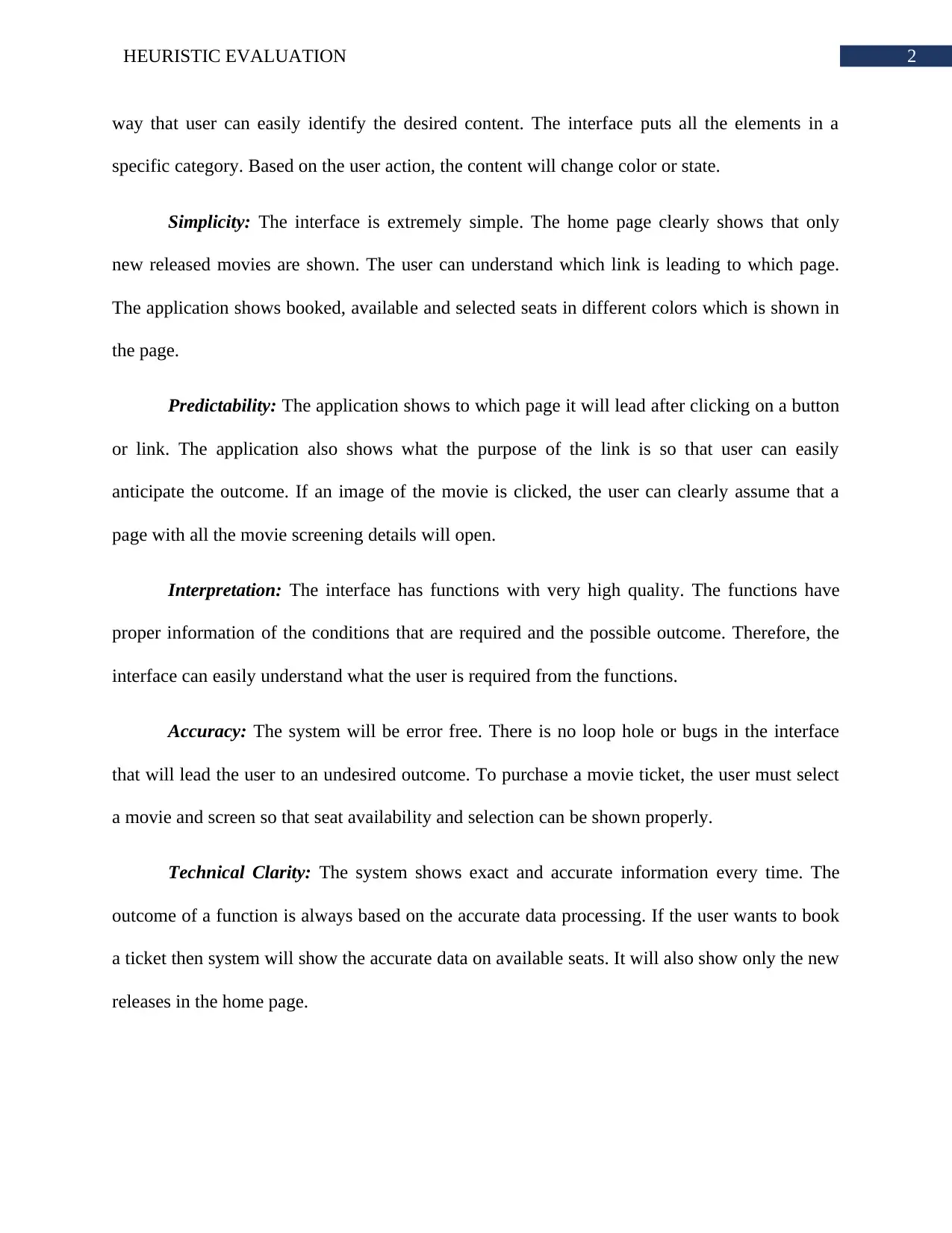
2HEURISTIC EVALUATION
way that user can easily identify the desired content. The interface puts all the elements in a
specific category. Based on the user action, the content will change color or state.
Simplicity: The interface is extremely simple. The home page clearly shows that only
new released movies are shown. The user can understand which link is leading to which page.
The application shows booked, available and selected seats in different colors which is shown in
the page.
Predictability: The application shows to which page it will lead after clicking on a button
or link. The application also shows what the purpose of the link is so that user can easily
anticipate the outcome. If an image of the movie is clicked, the user can clearly assume that a
page with all the movie screening details will open.
Interpretation: The interface has functions with very high quality. The functions have
proper information of the conditions that are required and the possible outcome. Therefore, the
interface can easily understand what the user is required from the functions.
Accuracy: The system will be error free. There is no loop hole or bugs in the interface
that will lead the user to an undesired outcome. To purchase a movie ticket, the user must select
a movie and screen so that seat availability and selection can be shown properly.
Technical Clarity: The system shows exact and accurate information every time. The
outcome of a function is always based on the accurate data processing. If the user wants to book
a ticket then system will show the accurate data on available seats. It will also show only the new
releases in the home page.
way that user can easily identify the desired content. The interface puts all the elements in a
specific category. Based on the user action, the content will change color or state.
Simplicity: The interface is extremely simple. The home page clearly shows that only
new released movies are shown. The user can understand which link is leading to which page.
The application shows booked, available and selected seats in different colors which is shown in
the page.
Predictability: The application shows to which page it will lead after clicking on a button
or link. The application also shows what the purpose of the link is so that user can easily
anticipate the outcome. If an image of the movie is clicked, the user can clearly assume that a
page with all the movie screening details will open.
Interpretation: The interface has functions with very high quality. The functions have
proper information of the conditions that are required and the possible outcome. Therefore, the
interface can easily understand what the user is required from the functions.
Accuracy: The system will be error free. There is no loop hole or bugs in the interface
that will lead the user to an undesired outcome. To purchase a movie ticket, the user must select
a movie and screen so that seat availability and selection can be shown properly.
Technical Clarity: The system shows exact and accurate information every time. The
outcome of a function is always based on the accurate data processing. If the user wants to book
a ticket then system will show the accurate data on available seats. It will also show only the new
releases in the home page.
⊘ This is a preview!⊘
Do you want full access?
Subscribe today to unlock all pages.

Trusted by 1+ million students worldwide
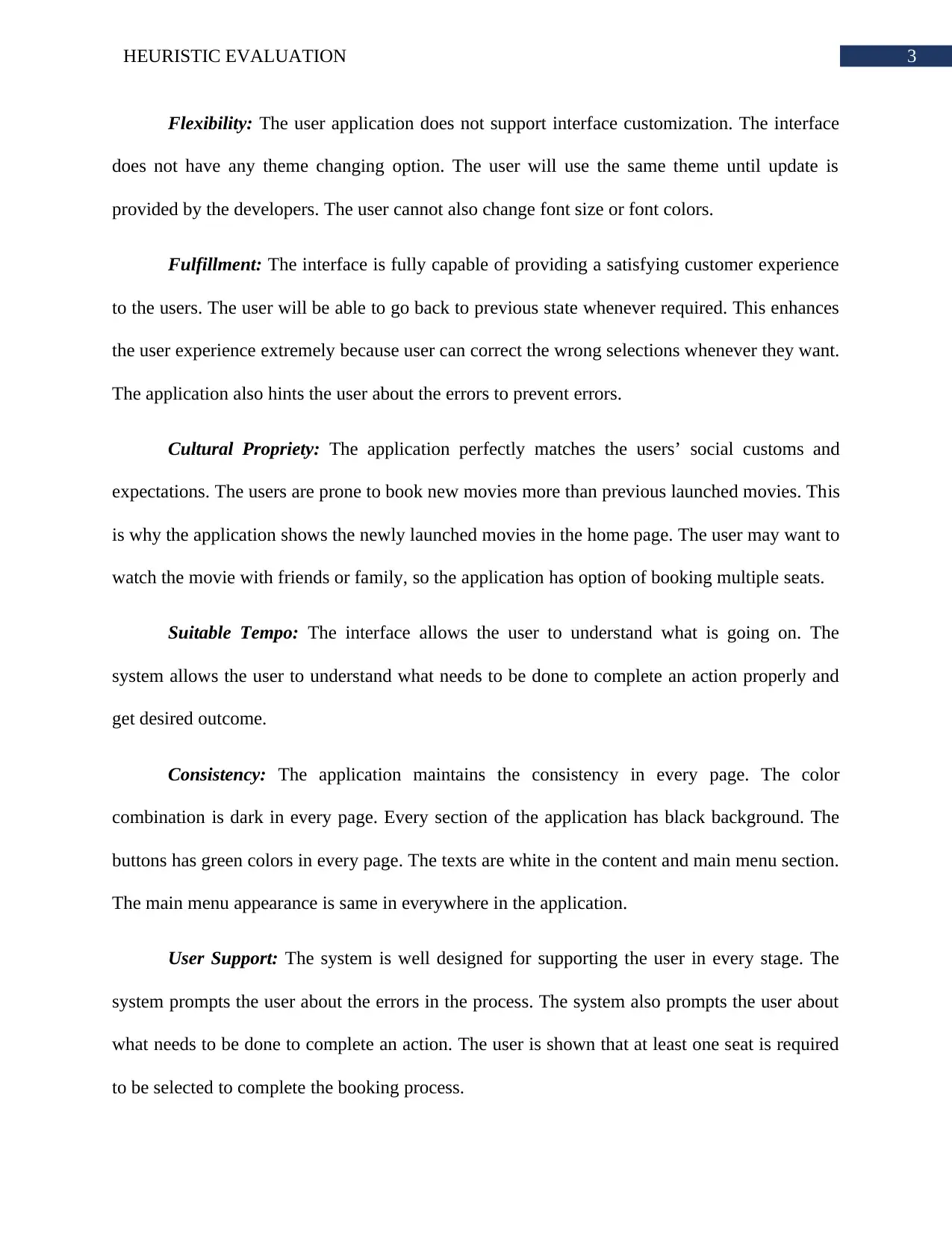
3HEURISTIC EVALUATION
Flexibility: The user application does not support interface customization. The interface
does not have any theme changing option. The user will use the same theme until update is
provided by the developers. The user cannot also change font size or font colors.
Fulfillment: The interface is fully capable of providing a satisfying customer experience
to the users. The user will be able to go back to previous state whenever required. This enhances
the user experience extremely because user can correct the wrong selections whenever they want.
The application also hints the user about the errors to prevent errors.
Cultural Propriety: The application perfectly matches the users’ social customs and
expectations. The users are prone to book new movies more than previous launched movies. This
is why the application shows the newly launched movies in the home page. The user may want to
watch the movie with friends or family, so the application has option of booking multiple seats.
Suitable Tempo: The interface allows the user to understand what is going on. The
system allows the user to understand what needs to be done to complete an action properly and
get desired outcome.
Consistency: The application maintains the consistency in every page. The color
combination is dark in every page. Every section of the application has black background. The
buttons has green colors in every page. The texts are white in the content and main menu section.
The main menu appearance is same in everywhere in the application.
User Support: The system is well designed for supporting the user in every stage. The
system prompts the user about the errors in the process. The system also prompts the user about
what needs to be done to complete an action. The user is shown that at least one seat is required
to be selected to complete the booking process.
Flexibility: The user application does not support interface customization. The interface
does not have any theme changing option. The user will use the same theme until update is
provided by the developers. The user cannot also change font size or font colors.
Fulfillment: The interface is fully capable of providing a satisfying customer experience
to the users. The user will be able to go back to previous state whenever required. This enhances
the user experience extremely because user can correct the wrong selections whenever they want.
The application also hints the user about the errors to prevent errors.
Cultural Propriety: The application perfectly matches the users’ social customs and
expectations. The users are prone to book new movies more than previous launched movies. This
is why the application shows the newly launched movies in the home page. The user may want to
watch the movie with friends or family, so the application has option of booking multiple seats.
Suitable Tempo: The interface allows the user to understand what is going on. The
system allows the user to understand what needs to be done to complete an action properly and
get desired outcome.
Consistency: The application maintains the consistency in every page. The color
combination is dark in every page. Every section of the application has black background. The
buttons has green colors in every page. The texts are white in the content and main menu section.
The main menu appearance is same in everywhere in the application.
User Support: The system is well designed for supporting the user in every stage. The
system prompts the user about the errors in the process. The system also prompts the user about
what needs to be done to complete an action. The user is shown that at least one seat is required
to be selected to complete the booking process.
Paraphrase This Document
Need a fresh take? Get an instant paraphrase of this document with our AI Paraphraser
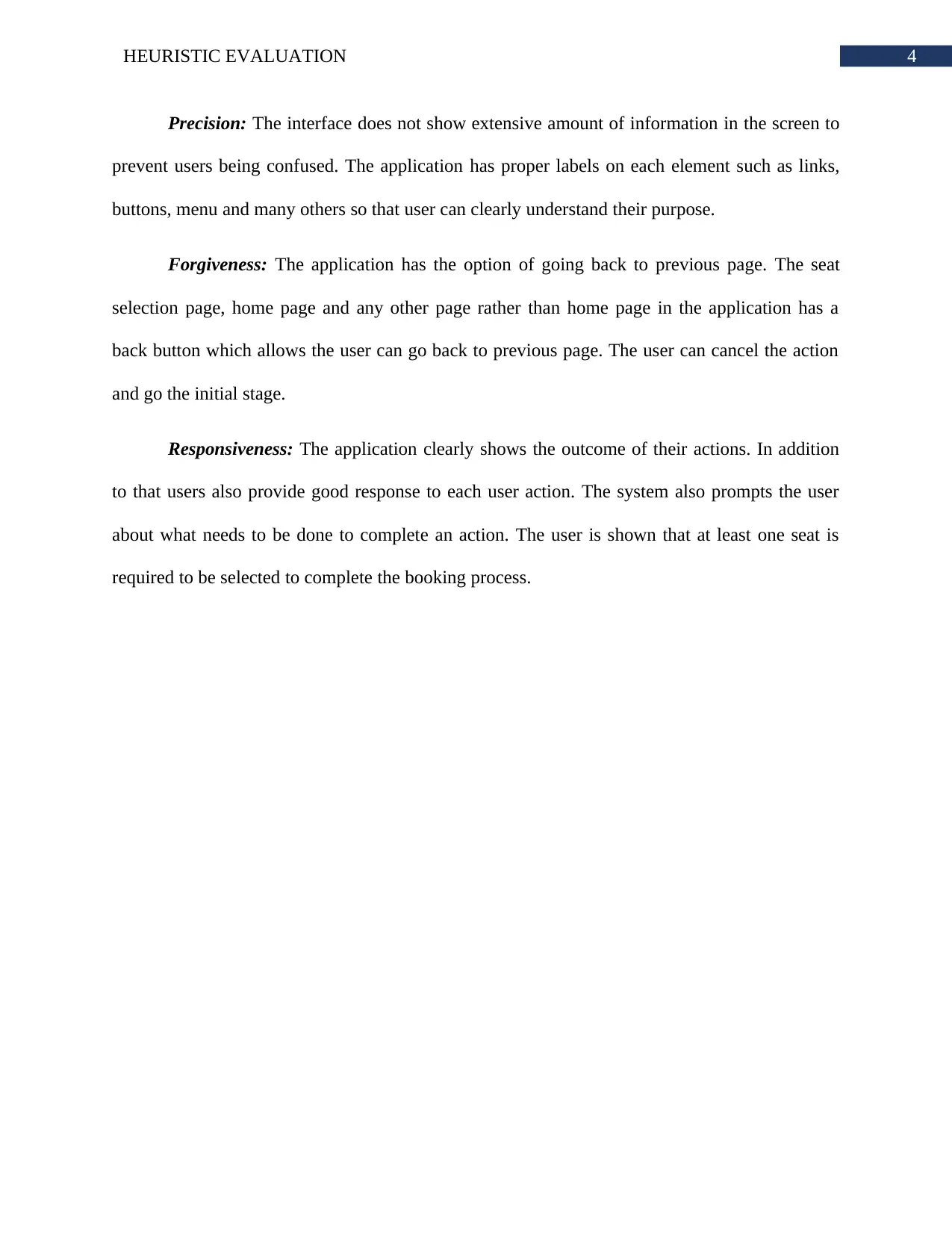
4HEURISTIC EVALUATION
Precision: The interface does not show extensive amount of information in the screen to
prevent users being confused. The application has proper labels on each element such as links,
buttons, menu and many others so that user can clearly understand their purpose.
Forgiveness: The application has the option of going back to previous page. The seat
selection page, home page and any other page rather than home page in the application has a
back button which allows the user can go back to previous page. The user can cancel the action
and go the initial stage.
Responsiveness: The application clearly shows the outcome of their actions. In addition
to that users also provide good response to each user action. The system also prompts the user
about what needs to be done to complete an action. The user is shown that at least one seat is
required to be selected to complete the booking process.
Precision: The interface does not show extensive amount of information in the screen to
prevent users being confused. The application has proper labels on each element such as links,
buttons, menu and many others so that user can clearly understand their purpose.
Forgiveness: The application has the option of going back to previous page. The seat
selection page, home page and any other page rather than home page in the application has a
back button which allows the user can go back to previous page. The user can cancel the action
and go the initial stage.
Responsiveness: The application clearly shows the outcome of their actions. In addition
to that users also provide good response to each user action. The system also prompts the user
about what needs to be done to complete an action. The user is shown that at least one seat is
required to be selected to complete the booking process.
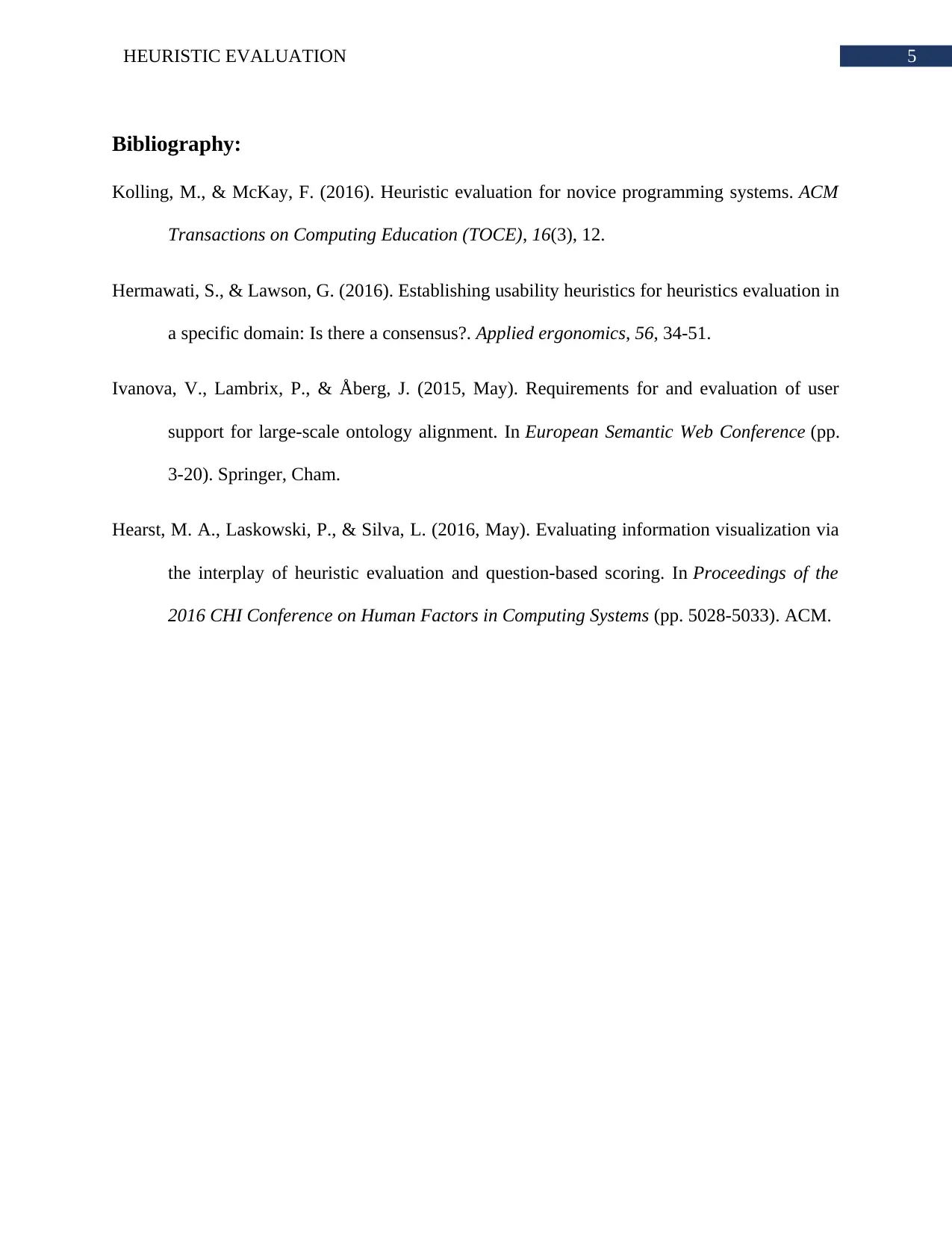
5HEURISTIC EVALUATION
Bibliography:
Kolling, M., & McKay, F. (2016). Heuristic evaluation for novice programming systems. ACM
Transactions on Computing Education (TOCE), 16(3), 12.
Hermawati, S., & Lawson, G. (2016). Establishing usability heuristics for heuristics evaluation in
a specific domain: Is there a consensus?. Applied ergonomics, 56, 34-51.
Ivanova, V., Lambrix, P., & Åberg, J. (2015, May). Requirements for and evaluation of user
support for large-scale ontology alignment. In European Semantic Web Conference (pp.
3-20). Springer, Cham.
Hearst, M. A., Laskowski, P., & Silva, L. (2016, May). Evaluating information visualization via
the interplay of heuristic evaluation and question-based scoring. In Proceedings of the
2016 CHI Conference on Human Factors in Computing Systems (pp. 5028-5033). ACM.
Bibliography:
Kolling, M., & McKay, F. (2016). Heuristic evaluation for novice programming systems. ACM
Transactions on Computing Education (TOCE), 16(3), 12.
Hermawati, S., & Lawson, G. (2016). Establishing usability heuristics for heuristics evaluation in
a specific domain: Is there a consensus?. Applied ergonomics, 56, 34-51.
Ivanova, V., Lambrix, P., & Åberg, J. (2015, May). Requirements for and evaluation of user
support for large-scale ontology alignment. In European Semantic Web Conference (pp.
3-20). Springer, Cham.
Hearst, M. A., Laskowski, P., & Silva, L. (2016, May). Evaluating information visualization via
the interplay of heuristic evaluation and question-based scoring. In Proceedings of the
2016 CHI Conference on Human Factors in Computing Systems (pp. 5028-5033). ACM.
⊘ This is a preview!⊘
Do you want full access?
Subscribe today to unlock all pages.

Trusted by 1+ million students worldwide
1 out of 6
Related Documents
Your All-in-One AI-Powered Toolkit for Academic Success.
+13062052269
info@desklib.com
Available 24*7 on WhatsApp / Email
![[object Object]](/_next/static/media/star-bottom.7253800d.svg)
Unlock your academic potential
Copyright © 2020–2025 A2Z Services. All Rights Reserved. Developed and managed by ZUCOL.
